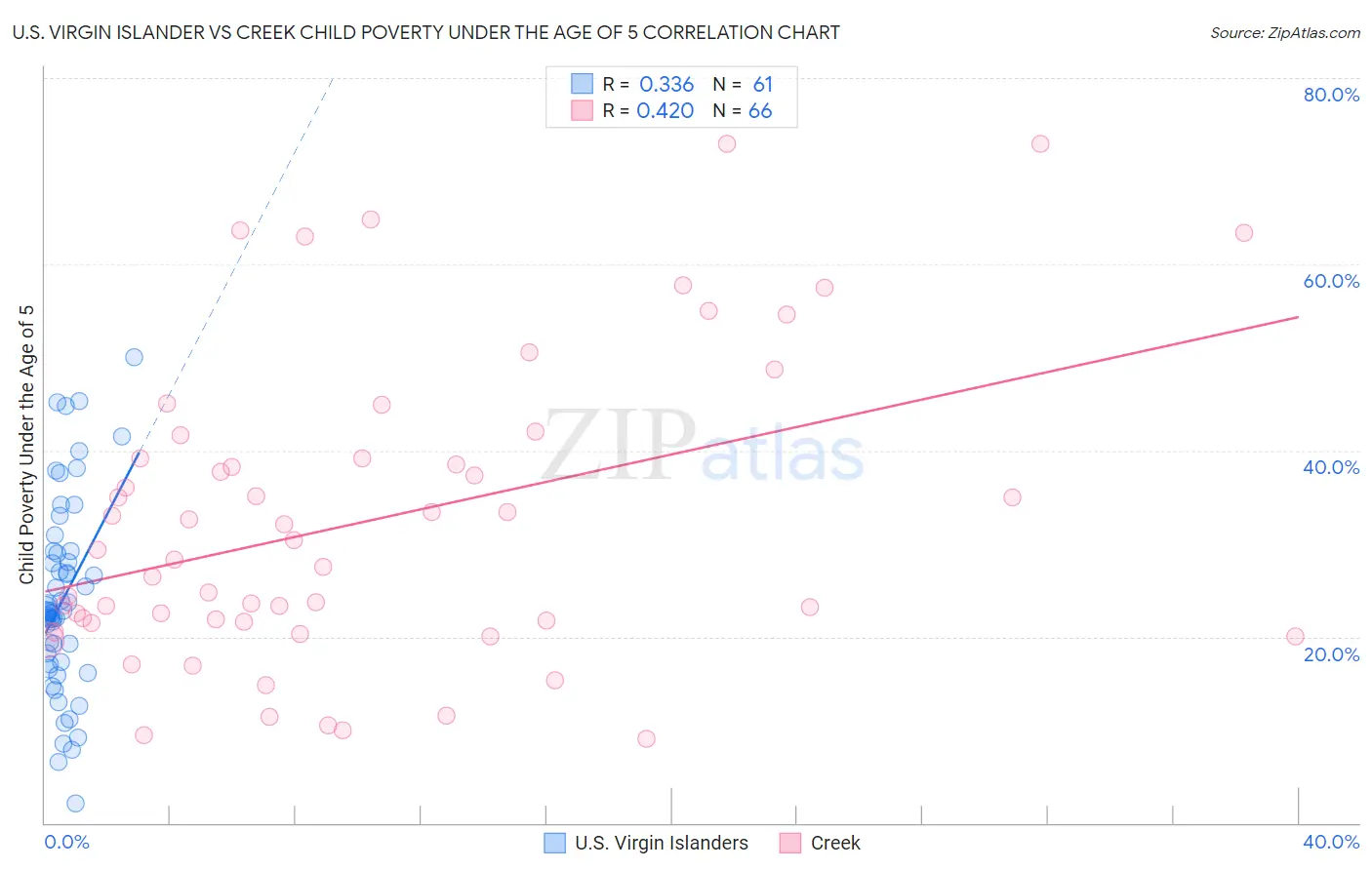U.S. Virgin Islander vs Creek Child Poverty Under the Age of 5
COMPARE
U.S. Virgin Islander
Creek
Child Poverty Under the Age of 5
Child Poverty Under the Age of 5 Comparison
U.S. Virgin Islanders
Creek
23.0%
CHILD POVERTY UNDER THE AGE OF 5
0.0/ 100
METRIC RATING
314th/ 347
METRIC RANK
24.2%
CHILD POVERTY UNDER THE AGE OF 5
0.0/ 100
METRIC RATING
330th/ 347
METRIC RANK
U.S. Virgin Islander vs Creek Child Poverty Under the Age of 5 Correlation Chart
The statistical analysis conducted on geographies consisting of 86,786,104 people shows a mild positive correlation between the proportion of U.S. Virgin Islanders and poverty level among children under the age of 5 in the United States with a correlation coefficient (R) of 0.336 and weighted average of 23.0%. Similarly, the statistical analysis conducted on geographies consisting of 175,779,647 people shows a moderate positive correlation between the proportion of Creek and poverty level among children under the age of 5 in the United States with a correlation coefficient (R) of 0.420 and weighted average of 24.2%, a difference of 5.3%.

Child Poverty Under the Age of 5 Correlation Summary
| Measurement | U.S. Virgin Islander | Creek |
| Minimum | 2.1% | 9.1% |
| Maximum | 50.0% | 73.0% |
| Range | 47.9% | 63.9% |
| Mean | 24.0% | 32.5% |
| Median | 22.7% | 28.8% |
| Interquartile 25% (IQ1) | 17.1% | 21.6% |
| Interquartile 75% (IQ3) | 29.0% | 39.1% |
| Interquartile Range (IQR) | 11.9% | 17.5% |
| Standard Deviation (Sample) | 10.3% | 16.2% |
| Standard Deviation (Population) | 10.2% | 16.1% |
Demographics Similar to U.S. Virgin Islanders and Creek by Child Poverty Under the Age of 5
In terms of child poverty under the age of 5, the demographic groups most similar to U.S. Virgin Islanders are Bahamian (23.0%, a difference of 0.090%), Honduran (23.0%, a difference of 0.14%), Arapaho (23.1%, a difference of 0.56%), Yakama (23.1%, a difference of 0.68%), and Menominee (23.3%, a difference of 1.2%). Similarly, the demographic groups most similar to Creek are Cajun (24.1%, a difference of 0.44%), Immigrants from Dominican Republic (24.1%, a difference of 0.67%), Dominican (24.0%, a difference of 0.76%), Kiowa (24.5%, a difference of 1.0%), and Central American Indian (23.9%, a difference of 1.2%).
| Demographics | Rating | Rank | Child Poverty Under the Age of 5 |
| Hondurans | 0.0 /100 | #312 | Tragic 23.0% |
| Bahamians | 0.0 /100 | #313 | Tragic 23.0% |
| U.S. Virgin Islanders | 0.0 /100 | #314 | Tragic 23.0% |
| Arapaho | 0.0 /100 | #315 | Tragic 23.1% |
| Yakama | 0.0 /100 | #316 | Tragic 23.1% |
| Menominee | 0.0 /100 | #317 | Tragic 23.3% |
| Dutch West Indians | 0.0 /100 | #318 | Tragic 23.3% |
| Chippewa | 0.0 /100 | #319 | Tragic 23.4% |
| Choctaw | 0.0 /100 | #320 | Tragic 23.5% |
| Immigrants | Honduras | 0.0 /100 | #321 | Tragic 23.5% |
| Ute | 0.0 /100 | #322 | Tragic 23.5% |
| Pueblo | 0.0 /100 | #323 | Tragic 23.7% |
| Paiute | 0.0 /100 | #324 | Tragic 23.8% |
| Immigrants | Congo | 0.0 /100 | #325 | Tragic 23.9% |
| Central American Indians | 0.0 /100 | #326 | Tragic 23.9% |
| Dominicans | 0.0 /100 | #327 | Tragic 24.0% |
| Immigrants | Dominican Republic | 0.0 /100 | #328 | Tragic 24.1% |
| Cajuns | 0.0 /100 | #329 | Tragic 24.1% |
| Creek | 0.0 /100 | #330 | Tragic 24.2% |
| Kiowa | 0.0 /100 | #331 | Tragic 24.5% |
| Apache | 0.0 /100 | #332 | Tragic 25.0% |